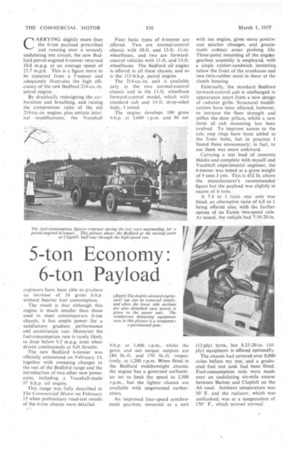Longer Lorries Needed : • Appeal Fails
Page 45

Page 46

If you've noticed an error in this article please click here to report it so we can fix it.
VEHICLES which could carry long loads were currently in demand, particularly by steel and motor works, the Transport Tribunal were told in London last week. Twentieth Century Transport, Ltd., Soho Road, Handsworth, Birrqingharrt, unsuccessfully appealed against the refusal of the West Midland Deputy Licensing Authority to grant them an A licence for two vehicles each 25 ft. long.
Mr. J. R. C. Samuel-Gibbon, for the company, said that the longest of their -present vehicles was 20 ft. Longer vehicles were required for lengthy consignments and for the carriage of 10-ton bulk loads of clay and chalk in powdered form.
Evidence had been given to the Authority of delays because of the difficulty in hiring vehicles from subcontractors.
Mr. Hubert Hull, president, said that today it seemed that no factory had any storage space and unless it could send its products away within 36 hours." the whole industry of this coun-try would come to an end."
Mr. Samuel-Gibbon said that townplanning requirements made it difficult to extend factories. His clients were prepared to surrender one of their present vehicles if a longer vehicle were allowed. Mr. Hull said that there might be a case for the company to seek the replacement of one of their special-Alicence lorries by a longer vehicle under ordinary A licence
WORKERS' INTEREST IN TRADE PROSPECTS •
EMPLOYEES are more interested in new developments and trade prospects for their company than they are in information about profits and what is done with them. This is one of the .conclusions reached in the report of a survey into the disclosure of financial information published by the British Institute of Management. The report, entitled " Presenting Financial Information to Employees" is obtainable from Management House, 8 Hill Street. London, WI.
" The main object of giving financial information,'.' the report states, "is to tpster an understanding of the comparty's affairs which will help to identify his own• interests with the company's continuing success. . . . Basically, we suggest that every employee, by .reason , of his employment, has a moral title to .information concerning the progress of his Company."
OILERS FOR SCHOOL SERVICE INDING oil-engined coaches half as expensive in fuel costs as petrolengined vehicles on school-bus services, London County Council are to order seven 12-seat oilers, instead of one, in the coming financial year. They will cost £29,383. Ten 31-seaters are also to be purchased.
CARRYING slightly more than the 6-ton payload prescribed and running over a severely undulating test circuit, the new Bedford petrol-engined 6-tonner returned 10.8 m.p.g. at an average speed of 25.7 mph. This is a figure more to be expected from a 5-toriner and adequately illustrates the high efficiency of the new Bedford 214-cu.-in. petrol engine.
By drastically redesigning the carburation and breathing, and raising the compression .ratio of the old 214Lcu.-in. engine, plus certain internal -modifications: the .Vauxhall
Four basic types of 6-tonner are offered. Two are normal-control chassis with 10-ft. and 13-ft. 11-in. wheelbases, and two are forwardcontrol vehicles with 11-ft. and 13-ft. ‘wheelbases. The Bedford oil engine is offered in all these chassis, and so is the 115-b.h.p. petrol engine.
The 214-cu.-in, unit is available only in the two normal-control chassis and in the 11-ft, wheelbase forward-control model, which with standard cab and I4-ft, drop-sided body, I tested.
The engine develops 100 gross b.h.p. at 3,600 r.p.m. and 86 net with me engine, gives more positivt and quicker changes, and greatei tooth coltact areas prolong life. Three-point mounting of the engisegearbox assembly is employed, with a single rubber-sandwich mounting below the front of the crankcase and two twin-rubber units in shear at the clutch housing.
Externally, the standard Bedford forward-control cab is unchanged in appearance apart from a new design of radiator grille. Structural modificatiOns have been effected, however. to increase the floor strength and stiffen the door pillars, whilst a new form of cab mounting has been evolved. To improve access to the cab; step rings have been added to the front hubs, but in practice I found these unnecessary., in fact, to use them was more awkward.
Carrying a test load of concrete blocks and complete with myself and Vauxhall experimental engineer, the 6-tonner was tested at a gross weight of 9 tons 3 cwt. This is 452 lb. above the manufacturer's recommended figure but the payload was slightly in excess of 6 tons.
A 7.4 to 1 -ratio rear axle was fitted, an alternative ratio of 6.8 to 1 being offered also, with.the further option of an Eaton two-speed axle. As tested, the vehicle had 7.50-20-in.












































































































